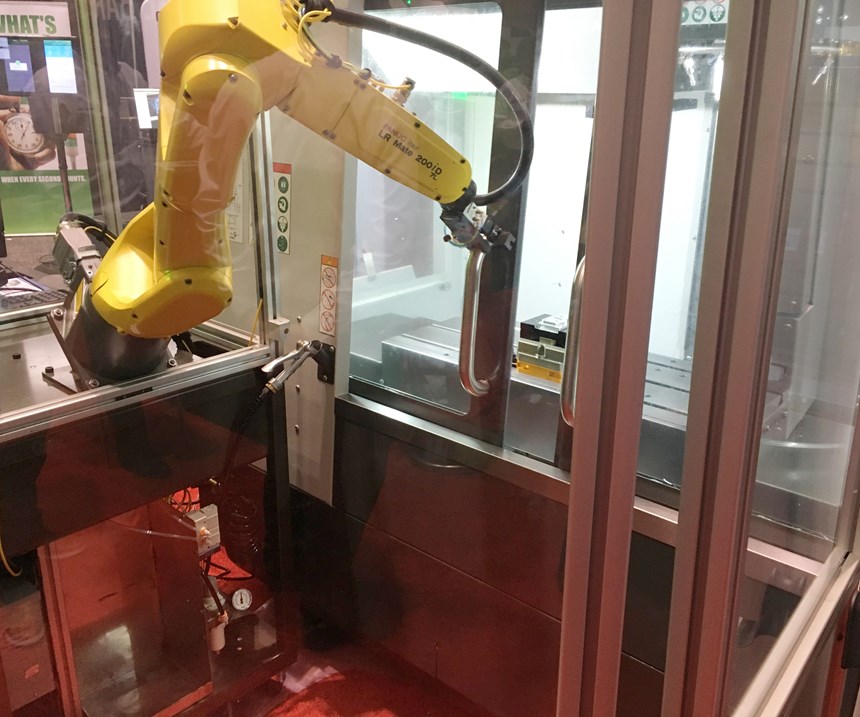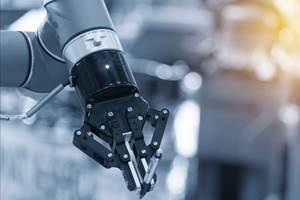10 Ways to Think Differently about Robotic Automation
Take another look: A lot is happening in and around robotic automation. What robots might mean for machining and manufacturing is getting ready to change.
Robots used to know their place. In the past, a robot would run behind a safety cage doing repetitive motions that rarely changed from week to week, let alone from day to day. Now it’s not so simple. Robots are, in many cases, easy to redeploy; collaborative robots (cobots) operate safely alongside people; and other advancing technologies seem to conspire with robots to make them even more effective. The result is an expanding scope of what robots might mean for manufacturing. Gathered over months from various events, discoveries, observations and conversations I’ve been party to recently, here are many glimpses of the changing nature of robots. Consider these points as a means of uncaging your own thinking about robotic automation, and perhaps even reconsidering what a robot might do for you:
1. Machine tool builders are adapting to robots. United Grinding’s Flexload, for example, is an add-on automation module by which the robot enters through one end of a grinding machine. The doors are still available for the operator, but for the sake of safety and temperature control, the robot’s access is different.
2. Robots are now seen to leverage labor, not replace it. Thyssenkrupp North America CEO Patrick Bass made this point at a recent Financial Times Live conference on manufacturing. The impact of low-cost automation such as a cobot includes the enthusiasm and engagement of the employee who has this resource, he says. A worker costing $67,000 annually becomes significantly more effective with the one-time investment in a $30,000 cobot.
3. Autonomous vehicles link robots’ efforts. Methods Machine Tools demonstrated this at the Smart Manufacturing Experience this year. A robot unloading parts from one machine placed them onto a self-guided vehicle delivering them to a different robot collecting the parts for inspection. The vehicle found its way around obstacles such as people, showing that a fixed track is no longer needed for automated systems to interconnect.
4. Redeployable robots simplify automation. Between cobots and traditional fixed industrial robots are redeployable robots mounted on platforms that make them easy to install and move from machine to machine. The Morris Group demonstrated an example of this from APT Manufacturing Solutions at the Smart Manufacturing Experience as well, and we recently wrote about a shop that is thriving with the approach to this idea from Halter.
5. China is the fastest-growing nation in robot use. This is partly a result of a deliberate emphasis on the technology by this country’s government. What we think of when we imagine manufacturing in China might change.
6. 3D printing is a complement to robotic automation. The one part-specific component of any robot application is liable to be the gripper. A 3D printer addresses this by offering a way to produce customized grippers or end effectors quickly. Additive manufacturing even realizes grippers that couldn’t be made another way.
7. Robot engineering addresses tight spaces. 3D printing also provides a means of prototyping the complex motion of robots designed to operate within a tight footprint. At this year’s Rapid + TCT event, MakerBot illustrated this with a 3D-printed robot prototype created by design engineers at Kuka Robotics for their KR 3 Agilus robot.
8. Inspection is an opportunity for robots. We think of robots doing the repetitive work of loading and unloading machine tools, but inspection is also repetitive work. Arnold Gauge was recently involved in an example: A customer needed 16,000 parts inspected by laser interferometry to detect a potential chatter problem in ID grinding. Company president Michael Bruns says a co-op student working on the problem less than a day was able to program a cobot to perform all the part handling for this inspection.
9. Cobots bring automation to old machines. Since they are inexpensive robots, cobots provide great opportunities for automating what might otherwise be considered lower-performing machine tools. At a recent event on robotics, TechSolve demonstrated a cobot from Universal Robots automating an older CNC lathe. No integration was needed, since the programmed motion of the robot included pulling the door handle to open and close the machine and pressing the control’s cycle-start button.
10. People are still needed. At that same TechSolve event, Robert Graff, senior sales manager of STEM education for Yaskawa America, described the need for robotics personnel seen by one manufacturer in particular, Honda’s Ohio plant, and what lengths this plant is taking to fill that need. A particularly fast-growing job title is “robot coordinator,” he says. Robots do replace human labor in some cases, but they are also driving the demand for different kinds of manufacturing professionals.
Related Content
Building an Automation Solution From the Ground Up
IMTS 2022 provides visitors the opportunity to meet with product experts to design automation solutions from scratch.
Read MoreChoosing a Five-Axis Machine Tool With Automation in Mind
While much focus is placed on the machinery that moves parts, the features most important for automating five-axis machining are arguably found in the machine tool itself.
Read More4 Steps to a Cobot Culture: How Thyssenkrupp Bilstein Has Answered Staffing Shortages With Economical Automation
Safe, economical automation using collaborative robots can transform a manufacturing facility and overcome staffing shortfalls, but it takes additional investment and a systemized approach to automation in order to realize this change.
Read MoreLean Approach to Automated Machine Tending Delivers Quicker Paths to Success
Almost any shop can automate at least some of its production, even in low-volume, high-mix applications. The key to getting started is finding the simplest solutions that fit your requirements. It helps to work with an automation partner that understands your needs.
Read MoreRead Next
3 Mistakes That Cause CNC Programs to Fail
Despite enhancements to manufacturing technology, there are still issues today that can cause programs to fail. These failures can cause lost time, scrapped parts, damaged machines and even injured operators.
Read MoreThe Cut Scene: The Finer Details of Large-Format Machining
Small details and features can have an outsized impact on large parts, such as Barbco’s collapsible utility drill head.
Read More
.jpg;width=70;height=70;mode=crop)














.png;maxWidth=300;quality=90)














